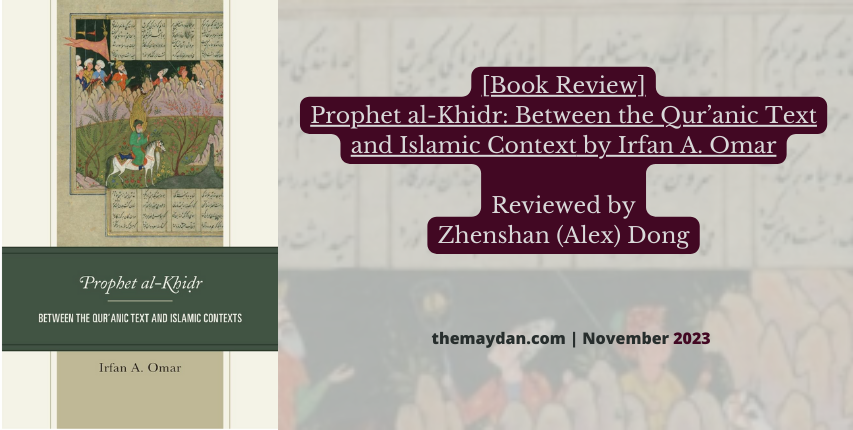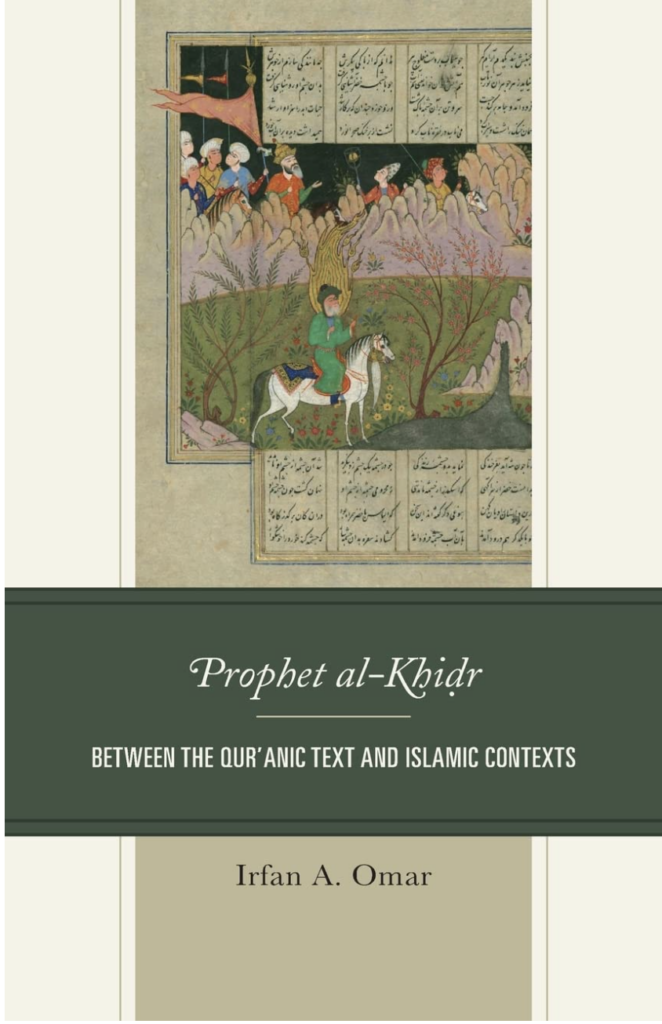
The hermeneutical transcendence of the stories of al-Khidr appears as the resonance of faith in human yearning for the world beyond our reach. Professor Irfan A. Omar’s Prophet al-Khidr: Between the Qur’anic Tet and Islamic Context takes us on a journey to explore the meaning-making process in the Islamic tradition surrounding the story of Khidr. In this enriched rendition of the widespread, multifaceted cultural phenomenon of Khidr, Omar illustrates how, through its interpretive reiteration and rejuvenation, the “passing-down” of the stories about this enigmatic figure offers us a glimpse into the workings of the transcendent reality within Islam. It is done by means of contextualizing the canonical, textual representations of these thoughts (80) into the historical, cultural, social and legal practicality rendered by the interpretations of their meanings. (79) This is the trajectory through which this book introduces the reader to the story of Khidr- and to the complex weaving of the historical, socio-political and cultural backgrounds against which it is told and retold for centuries.
In this enriched rendition of the widespread, multifaceted cultural phenomenon of Khidr, Omar illustrates how, through its interpretive reiteration and rejuvenation, the “passing-down” of the stories about this enigmatic figure offers us a glimpse into the workings of the transcendent reality within Islam.
For Omar, our questions about Khidr’s story are as much about the given analyses as they are about sustaining the meaning-making process. Borrowing Omar’s own words, “Khidr liberates even as attempts are continually made to constrict him historically, culturally and exegetically (4),” The figure of Khidr transcends the textual references of his legacy and symbolizes the faithful aspirations that continue to inspire many beyond the limitation of time. Like the stories of al-Khidr, this book offers enduring insights that expand Islamic scholarship by inviting cross-cultural references, thereby allowing the readers to generate contextualizing meanings beyond one’s limitations. The book consists of five chapters; each can be seen as a unique window through which the significance of Khidr’s story is viewed.
The first chapter, titled “The Origin and Meanings of the Khidr Story,” dissects various theological implications surrounding the Quranic account of the story about the first appearance of the “Servant of God.” Recalling the essential passages concerning Moses’ encounter with Khidr found in Surah al-Kahf, 18:60-82, this chapter outlines two main dyads in juxtaposition with Moses-Khidr encounter: esoteric and exoteric knowledge (16), law and revelation (17), humanity and divinity (22). The outline of these dyads sets up a general conceptual schema that leads into a discussion on interpretative differences and multiple Islamic narratives that exists within the orthodox and Sufi scholarship (19). In turn, this framework demonstrates the philosophical significance that the figure of Khidr embodies. While learning about Khidr’s identity, status, and relevance are pivotal to our understanding of the traditional interpretations of the stories we inherit, they are also pertinent to our reassessment of our own hermeneutical treatment of these traditions, thereby alluding to the characteristics of the religio-cultural ethos in Muslim societies (23) and their preservation in a cross-cultural continuum (27).
The second chapter, titled “Khidr in Muslim Sources and Traditions of Piety,” provides a more detailed analysis of al-Khidr and the spiritual qualities he symbolizes in the traditional Quranic scholarship. Starting with the relationship between Moses and Khidr, defined by the epistemologically critical dyads concerning esoteric-exoteric knowledge and law-revelation, this chapter examines the role that the concept of knowledge and mercy play in constructing Khidr’s religious identity. To understand the traditions regarding whether al-Khidr can be adequately identified as a prophet or a saint, as well as his ranking in comparison to Moses. While many would make well-grounded claims focusing either on the superiority of Moses or that of Khidr, Ibn Arabī would argue that Moses possesses esoteric knowledge, whereas Khidr possesses exoteric knowledge; both are relevant and valuable (41). According to Omar, this comprehensive view juxtaposes the crux of Sufi scholarship—independent of popular, orthodox Islamic beliefs—with many interpretive possibilities. Because of its inclusiveness, embracing this view allows us to rejuvenate our hermeneutical minds toward the meanings of representational symbolisms embedded in Khidr’s story, such as that of being green (43-4), fish and water (44-5), being in transit (45-6), and immortality (46-50).
If we are to see the previous two chapters as tending more toward demonstrating the representational symbolization of Khidr’s stories as derived from its textual basis, we would recognize that there exists not only a shift in the topic but also a subtle repositioning of conceptual approach in chapter three. In that regard, the third chapter, “Khidr in Sufism,” can be seen as a transitory disposition that moves our focus from the textual analysis of the symbolization of Khidr’s stories to the contextualization of these stories by approaching the figure of Khidr as a personification of mystical qualities and the embodiment of mystical practices of faith. This chapter introduces mysticism and the history of Sufism. Here, the notion of knowledge is no longer approached simply on a conceptual plane—that is, it is no longer a concept through which the identity of Khidr can be qualified only theoretically—instead, the concept of knowledge granted by the divine is now seen in juxtaposition with the practice of faith, where mysticism is viewed as “a part of religion, a way of life and a process of communicating the inner experience of the presence of the divine (57).” With an emphasis drawn on the aspects of tasawwuf, this chapter situates the role Khidr plays in Sufism and examines the pragmatic aspects of the story. For Sufis, Khidr is the hidden “immortal personification of the initiatic principle” through which a seeker begins their journey on the mystical path (59). In Sufism, Khidr’s legacy is preserved as a transcendental, transhistorical inspiration for the followers to come. Under this framework, the qualities of piety, such as servitude (61), humility (63), discipleship (66), and the practical reflection of divine light (68-73), are seen not only as apparatuses that construct a contrast between differing approaches but also as a testament to how the figure of Khidr is able to blur the sharp distinction between orthodox renderings of the divine command and his popular manifestations (73).
Chapter four provides further consideration of the cultural saturation spread through Islamic folklore. This chapter is oriented toward understanding how the moral aspect of Khidr’s presence in popular traditions manifests through the interpretational matrix through history (79). The crux of this chapter is the dialectical movement between how the Sufi’s understandings impact our view of the textual and mystical portrayal of Khidr, and how our view could impact the contextualization of Khidr as a figure “situated between the two realms of belief and practice (79).” As a transhistorical figure that symbolizes boundless immortality, Khidr is appreciated by different cultures as someone who “epitomizes the perfectibility of the human soul (83). As the author demonstrates, references to the stories of Khidr can be found across various Western and Asian cultures (85-93), as well as Rabbinic literature and crossing path with early Jewish culture in general (93-5), thus cementing the idea that Khidr is the transhistorical and transcultural vehicle for the “transnational Islamic empire of faith (92).”
The emphasis of Khidr’s legacy is placed on the idea of the self, which epitomizes the question of how best we ought to manage our actions to follow the path toward human fulfilment that Khidr demonstrates.
If chapter four provides us with an opportunity to see Khidr as a transcultural, transhistorical, and transnational figure that embodies the Islamic faith, the portrayal in chapter five allows us to access a more fundamental perspective of this embodiment, and subsequently, a more interpersonal aspect of the Islamic faith. Titled “Khidr in Muhammad Iqbal’s Poetry,” this chapter examines Iqbal’s unique poetic projection of Khidr’s stories. Here, al-Khidr is depicted with “the purpose of highlighting [poets’] respective visions of mystery and divine workings in the world (103).” For the poets, Khidr’s prophetic characteristics illustrate the “unlimited potential of human beings (104).” In this sense, Khidr’s path manifests as viable guidance for any sincere seeker. The emphasis of Khidr’s legacy is placed on the idea of the self, which epitomizes the question of how best we ought to manage our actions to follow the path toward human fulfilment that Khidr demonstrates. Instead of following the traditions of faith unreflectively (taqlīd), Iqbāl emphasizes the importance of khudī and advocates for the crucial reexamination of the self (105-9). It is in this sense that Khidr’s legacy that embodies the Islamic faith can be realized through the individual’s dedication to perfecting their actions.
Throughout the book, the prominence of symbolism persists as we attempt to generate more interpretative nuances to better sustain the process of meaning-making surrounding the story of Khidr. Within the discussion of various symbolisms, the idea of immortality seems to play a pivotal role in connecting theology with the practical adaptation of the Islamic faith from various cultures and contrasting the orthodox interpretive take on Islamic traditions with Sufism. For readers, a general curiosity about immortality might linger—what other interpretations might we produce about Khidr, given that the concept of immortality itself could symbolize various aspects of the Islamic understanding of life and eternity and one’s relationship with Allah?
Overall, Prophet al-Khidr: Between the Qur’anic Tet and Islamic Context is a hermeneutically dynamic take on interpreting the legends of Khidr by situating us in the flow of humanity.
Overall, Prophet al-Khidr: Between the Qur’anic Tet and Islamic Context is a hermeneutically dynamic take on interpreting the legends of Khidr by situating us in the flow of humanity. This work serves as an overview that introduces the general audience to the mighty empire of Islamic ideas, which are pivotal to the understanding of the various analyses of Khidr’s stories and crucial for us to contemplate our practical approaches concerning the Islamic faith. For academic readers, this work serves as a well-constructed blueprint that lays out an enriched analysis of the contents of Islamic interpretive narratives surrounding Khidr’s stories by situating these stories in a multifaceted context. This comprehensive study provides the readers—general audiences and academic scholars alike—with well-formulated reflection on how Khidr’s stories can transcend the vast scholarship of Islamic theology into the practice of Islamic faith in the tradition of Sufism.
Zhenshan (Alex) Dong is a PhD student at the Department of Philosophy at Marquette University. His research interests include philosophy of race with a focus on Asian communities, metaphysics, and subjectivity.


